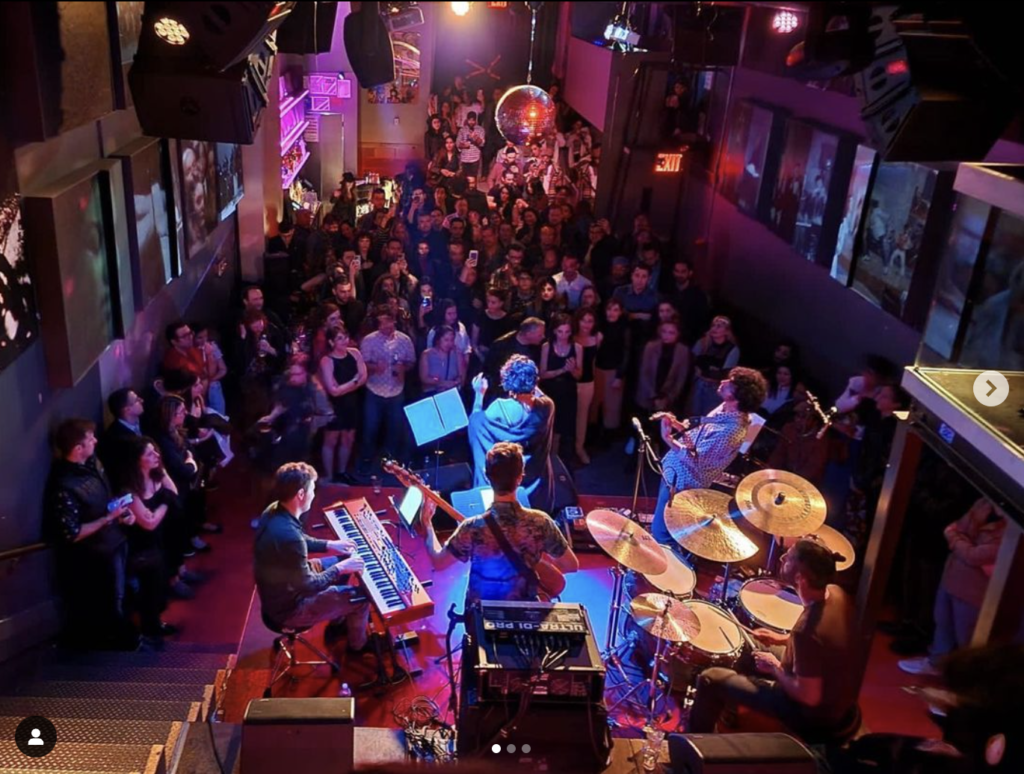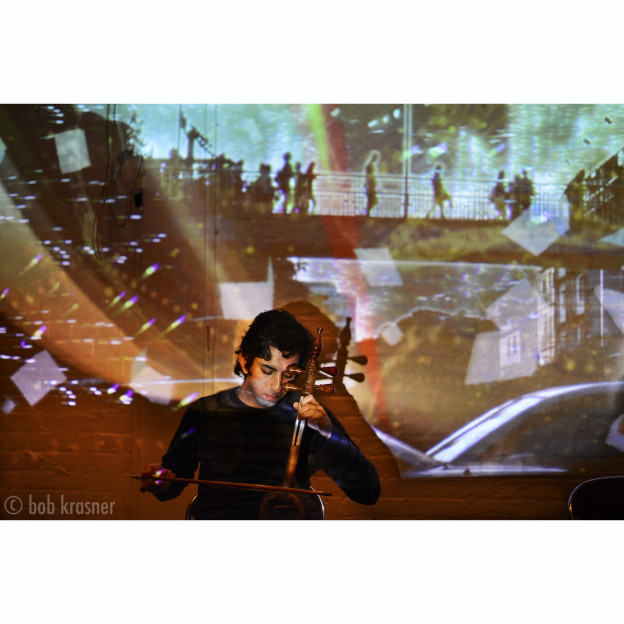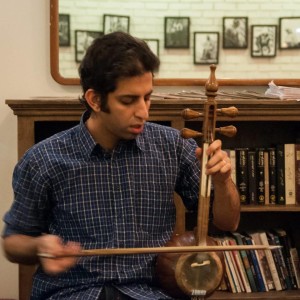Interview by Dawoud Kringle (DK)
DooBeeDooBeeDoo NY interviewed Iranian musician Kaveh Haghtalab (KH) (https://doobeedoobeedoo.info/kaveh-haghtalab-an-iranian-musicians-perspective-of-nys-music-scene/). This is part two of that interview, where we delve deeper into Kaveh’s experiences and work as a musician.
DK: You’ve been involved with several bands in New York since you moved here in 2012, one of which is SoSaLa. How did you become involved with them?
KH: SoSaLa is one of the first bands I started working with in New York when I graduated from the Collective. The band has a unique sound, combining standard jazz and funk instrumentation and grooves with instruments like the Kamancheh, cello, dobro, and SoSaLa’s saxophone, which sometimes emulates the Persian wind instrument, Sorna. This blend feels like home to me because it allows for greater expression. I’ve played shows with them and was featured on the album Nu World Trashed. I’m looking forward to making more music with them in the future.
DK: How did you become involved with Musicians For Musicians (MFM), and what have you been doing within the organization?
KH: I joined MFM because I wanted to educate myself as a professional musician on how to successfully run a personal music business and support my peers in the same effort. When I was about to release a song, I realized there are many nuances regarding publishing rights and how musicians collect their hard-earned royalties, and the available information isn’t beneficial. MFM is a great community with experienced musicians willing to share with other members. The core value of MFM, fighting for musician rights and fostering musicians’ camaraderie, aligns with my beliefs.
DK: Surviving as a freelance musician in New York is not easy. Yet you manage to do so. How do you accomplish this?
KH: Paying rent through music has never been easy, but there are ways to make it work. Our band Koubeh had a hit song, “Kook,” which has opened doors for more concert bookings and funds to create more music. Also, I’ve been working as a session musician on various projects consistently over the past few years. Involvement in music curriculum development also provides stable support.
DK: Tell us more about your band Koubeh. How did that project begin? You also mentioned that Koubeh recently produced a single titled “Kook.” I must say, I enjoyed listening to it! What’s that song about? How did it evolve?
KH: I initiated the band as a small project to support friends passionate about music and seeking deeper involvement. However, we quickly shifted our focus to compositions and arrangements rooted in Persian regional folk songs, a passion of mine that resonated with my bandmates. We put together a set list and began performing shows in Brooklyn, receiving positive feedback. The song “Kook” was one of the compositions by our accordion player Nima Farzaneh. When Nima and our singer Sima Shahverdi were about to move to the Bay Area, we were not sure what the future of the band would look like, and we decided to record the song with a modest budget. We got together in Nima’s apartment, recorded the song live with a video, and released it, which proved successful and accumulated over 10 million views on Instagram. The song is about a love story.
View this post on Instagram
DK: Persian classical music has become an integral part of the world music/roots music scene in the US. Tell us your thoughts and experiences about its place in the music market, and what you envision as its future.
KH: There was an era before and after Iran’s 1979 revolution where Iranians viewed anything related to their own culture and traditions as inferior, including Iranian or Persian Classical Music. However, attitudes are changing as people in the US and Europe are more open to and sometimes embrace classical art forms and cultures of Asian traditions. We’ve witnessed musicians like Haj Ghorban Soleimani, a legendary dotar player from Khorasan, gaining worldwide recognition overnight. This shift has led Iranians to recognize the value of their heritage. The essence of Iranian Classical Music, reflecting the beauty of the universe akin to Rumi and Hafez poems, is timeless and will live through generations.
DK: Is there a market for this kind of roots music in the US?
KH: Yes, there is, with different opportunities depending on the direction the artist takes. While not as accessible as markets for more mainstream genres, niche markets exist. Venues and organizations such as the Asia Society, the Rubin Museum, and the Diaspora Arts Connection are interested in this genre. I have friends who perform at festivals like the Richmond Folk Festival, which I plan to apply for next year. A producer friend has encouraged me to create short snippets of Kamancheh melodies for platforms used by film and hip-hop composers, as there’s a lack of Persian music available. There are various ways to succeed; it just requires creativity in the business approach.
DK: Is there a network of American-Iranian musicians in any genre in the US? Are you aware of some Iranian female musicians such as Kamancheh player and composer Niloufar Shir, and the Iranian Female Composers Association (IFCA)?
KH: I’m not familiar with Niloufar Shir, but I’m intrigued to look her up. Two of my good friends and colleagues, Bahar Royaee and Niloufar Nourbakhsh, are members of IFCA. They are incredibly talented musicians and always inspire me. It’s amazing to see Iranian female musicians achieve such success and mastery of their craft despite the limitations they’ve faced because of where they grew up.
As for a specific formal network, I’m not aware of one per se, but some of us know each other and stay in touch. There are associations like the Diaspora Art Connection in SF and the Emruz Festival that organize concerts for Iranians.

DK: Have you heard about the post-punk band SAVAK led by Sohrab Habibion?
KH: I haven’t, but will look them up!
DK: You mentioned that you have done some sessions and that you are involved with SoSaLa. Please tell us a little more about the other non-Persian music projects you are or have been involved with.
KH: One of the projects I’ve been involved with since I moved to New York was the band Fellaheen. Bruce Hanson, the person behind that project, is a great musician, and I enjoy working with him. We had a great time going to the studio and recording music together. Other projects include Mitra Sumara, to which I got connected thanks to Sosala, and Parnaz Partovi, a great Iranian singer-songwriter with whom I’ve been collaborating for years, working on arrangements and assembling bands for her shows. Additionally, I frequently get called to the studio as a freelancer.

Kaveh Haghtalab w. Mitra Sumara (photo: courtesy of Kaveh Haghtalab)
DK: How would you describe the way Persian / Iranian musicians are treated and accepted in the musical/artistic circles?
KH: Within musical and artistic circles, Iranian musicians are often embraced for their talent, cultural contributions, and unique perspectives. Despite external factors, their artistry and creativity tend to go over political boundaries. I believe musicians, especially those from different parts of the world, have the opportunity to challenge stereotypes and bridge the gaps created by politics.
DK: If there was a single unrealized ambition you have, a single goal or project you would like to achieve with your music, what would it be?
KH: My parents are from a village in the eastern part of Iran called Ferdows, which translates to “paradise” in Farsi. Sadly, the village was ravaged by an earthquake in 1962, during which my mother lost her parents and a sister at a young age. Growing up, she would share vivid stories of Ferdows – its charming houses, the kindness of its people, saffron farms, the oasis in the desert, and the underground water reservoirs. These tales painted a beautiful picture of Ferdows before the earthquake, almost as if I had lived there during my childhood. I aim to create an album that reflects the essence of Ferdows, its people, and my parents, translating these emotions into music.
Those of you fortunate enough to have heard Kaveh’s music will notice how it reflects his journey as an immigrant musician. More than that, it is evidence of the human spirit and the power of music transcending national boundaries and political corruption. His contributions to the arts in America underscore the importance of supporting diverse voices in the music industry.



